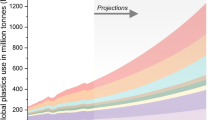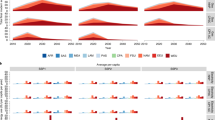Abstract
Increasing plastic waste pollution has led to a rising prevalence of the open burning of plastic waste, especially in locations lacking formal waste-management systems. Urban slum communities face particularly acute challenges in accessing both organized waste-collection services and low-cost traditional energy sources, and clean cooking-fuel alternatives tend to be unaffordable for their low-income residents. Here we examine the potential risk these unseen communities face and describe the need for a new research agenda to better understand and quantify the scope of the problem. The Global South is urbanizing at a rapid rate. Moreover, in many countries, this urbanization is outpacing the expansion of amenities and economic opportunities. With global plastic use predicted to triple by 2060 and two-thirds of the global population estimated to be living in urban areas by 2050, this Perspective draws attention to the nexus of sanitation and energy poverty, and the potential problems it poses for many low-income urban dwellers. An increasing number of energy-poor households, surrounded by plentiful waste plastic, are believed to be burning waste to both meet their energy needs and manage waste, although the evidence is limited and far from representative. We discuss the factors that may push marginalized households in cities of the Global South to burn waste plastic, and why this possibility is so concerning, before closing with a call for applied research to better understand the scale and scope of the phenomenon and its consequences.
This is a preview of subscription content, access via your institution
Access options
Subscribe to this journal
Receive 12 digital issues and online access to articles
$119.00 per year
only $9.92 per issue
Buy this article
- Purchase on SpringerLink
- Instant access to full article PDF
Prices may be subject to local taxes which are calculated during checkout



Similar content being viewed by others
References
World Bank. Data (The World Bank, 2024).
Parnell, S. & Oldfield, S. The Routledge Handbook on Cities of the Global South (Routledge, 2014).
Dados, N. & Connell, R. The Global South. Contexts 11, 12–13 (2012).
Raleigh, C. The search for safety: the effects of conflict, poverty and ecological influences on migration in the developing world. Global Environ. Change 21, S82–S93 (2011).
Sedova, B. & Kalkuhl, M. Who are the climate migrants and where do they go? Evidence from rural India. World Dev. 129, 104848 (2020).
Ezeh, A. et al. The history, geography and sociology of slums and the health problems of people who live in slums. Lancet 389, 547–558 (2017).
Kit, O., Lüdeke, M. & Reckien, D. Defining the bull’s eye: satellite imagery-assisted slum population assessment in Hyderabad, India. Urban Geogr. 34, 413–424 (2013).
Ghosh, S., Seth, P. & Tiwary, H. How does Covid-19 aggravate the multidimensional vulnerability of slums in India? A commentary. Soc. Sci. Humanit. Open 2, 100068 (2020).
Li, C. et al. Slum and urban deprivation in compacted and peri-urban neighborhoods in sub-Saharan Africa. Sustain. Cities Soc. 99, 104863 (2023).
Leng, S., Sun, R., Yang, X. & Chen, L. Global inequities in population exposure to urban greenspaces increased amidst tree and nontree vegetation cover expansion. Commun. Earth Environ. 4, 464 (2023).
Endreny, T., Sica, F. & Nowak, D. Tree cover is unevenly distributed across cities globally, with lowest levels near highway pollution sources. Front. Sustain. Cities https://doi.org/10.3389/frsc.2020.00016 (2020).
Follmann, A., Willkomm, M. & Dannenberg, P. As the city grows, what do farmers do? A systematic review of urban and peri-urban agriculture under rapid urban growth across the Global South. Landsc. Urban Plan. 215, 104186 (2021).
Devkota, P., Dhakal, S., Shrestha, S. & Shrestha, U. B. Land use land cover changes in the major cities of Nepal from 1990 to 2020. Environ. Sustain. Ind. 17, 100227 (2023).
Gill-Wiehl, A., Ray, I. & Kammen, D. Is clean cooking affordable? A review. Renew. Sustain. Energy Rev. 151, 111537 (2021).
Pathak, G. et al. Plastic pollution and the open burning of plastic wastes. Global Environ. Change 80, 102648 (2023).
Pachauri, S., Poblete-Cazenave, M., Aktas, A. & Gidden, M. J. Access to clean cooking services in energy and emission scenarios after COVID-19. Nat. Energy 6, 1067–1076 (2021).
WHO. Household air pollution. WHO https://www.who.int/news-room/fact-sheets/detail/household-air-pollution-and-health (World Health Organization, 2022).
Mills, E. Global kerosene subsidies: an obstacle to energy efficiency and development. World Dev. 99, 463–480 (2017).
Wekesa, C., Mutta, D., Larwanou, M., Kowero, G. & Roos, A. Effects of charcoal ban on value chains and livelihoods in Kenyan coast – stakeholders’ perceptions. Environ. Dev. 45, 100809 (2023).
ICLEI Africa. Clean cooking in African informal settlements. ICLEI Africa https://africa.iclei.org/clean-cooking-in-african-informal-settlements/ (ICLEI Africa, 2023).
Bharadwaj, B., Malakar, Y., Herington, M. & Ashworth, P. Context matters: unpacking decision-making, external influences and spatial factors on clean cooking transitions in Nepal. Energy Res. Soc. Sci. 85, 102408 (2022).
Buyana, K., Byarugaba, D., Sseviiri, H., Nsangi, G. & Kasaija, P. Experimentation in an African neighborhood: reflections for transitions to sustainable energy in cities. Urban Forum 30, 191–204 (2019).
Cook, E. & Velis, C. A. Global Review on Safer End of Engineered Life (Engineering X, 2020).
FAO. Global Forest Resources Assessment 2020, 184 (Forest and Agriculture Organization, 2020).
UNEP. Global Waste Management Outlook 2024: Beyond an Age of Waste—Turning Rubbish into a Resource (United Nations Environment Programme, 2024).
OECD. Global Plastics Outlook (OECD, 2022).
Geyer, R., Jambeck, J. R. & Law, K. L. Production, use and fate of all plastics ever made. Sci. Adv. 3, e1700782 (2017).
Jambeck, J. et al. Challenges and emerging solutions to the land-based plastic waste issue in Africa. Mar. Policy 96, 256–263 (2018).
Barnes, S. J. Out of sight, out of mind: plastic waste exports, psychological distance and consumer plastic purchasing. Glob. Environ. Change 58, 101943 (2019).
Gómez-Sanabria, A., Kiesewetter, G., Klimont, Z., Schoepp, W. & Haberl, H. Potential for future reductions of global GHG and air pollutants from circular waste management systems. Nat. Commun. 13, 106 (2022).
Vane, C. H. et al. Impact of organic pollutants from urban slum informal settlements on sustainable development goals and river sediment quality, Nairobi, Kenya, Africa. Appl. Geochem. 146, 105468 (2022).
Cottom, J. W., Cook, E. & Velis, C. A. A local-to-global emissions inventory of macroplastic pollution. Nature 633, 101–108 (2024).
Fedak, K. M. et al. An expert survey on the material types used to start cookstoves. Energy Sustain. Dev. 48, 59–66 (2019).
Ezéchiel, K., Joel, T. K., Soulouknga, M. H. & Roger, D. D. Production and characterization of ecological fire starter from sawdust and vegetable oil. Heliyon 9, e18253 (2023).
Nxumalo, S. M., Mabaso, S. D., Mamba, S. F. & Singwane, S. S. Plastic waste management practices in the rural areas of Eswatini. Soc. Sci. Humanit. Open 2, 100066 (2020).
The World Bank. Nigeria—Multi-Tier Framework (MTF) (The World Bank, 2020).
Elbayoumi, M. & Albelbeisi, A. H. Biomass use and its health effects among the vulnerable and marginalized refugee families in the Gaza Strip. Front. Public Health 10.3389/fpubh.2023.1129985 (2023).
Petrlik, J. et al. Monitoring dioxins and PCBs in eggs as sensitive indicators for environmental pollution and global contaminated sites and recommendations for reducing and controlling releases and exposure. Emerg. Contam. 8, 254–279 (2022).
Hedman, B., Näslund, M., Nilsson, C. & Marklund, S. Emissions of polychlorinated dibenzodioxins and dibenzofurans and polychlorinated biphenyls from uncontrolled burning of garden and domestic waste (backyard burning). Environ. Sci. Technol. 39, 8790–8796 (2005).
Mentes, D. et al. Combustion behaviour of plastic waste—a case study of PP, HDPE, PET and mixed PES-EL. J. Clean. Prod. 402, 136850 (2023).
Tomsej, T. et al. The impact of co-combustion of polyethylene plastics and wood in a small residential boiler on emissions of gaseous pollutants, particulate matter, PAHs and 1,3,5-triphenylbenzene. Chemosphere 196, 18–24 (2018).
Spengler, R. N. Dung burning in the archaeobotanical record of West Asia: where are we now? Veg. Hist. Archaeobot. 28, 215–227 (2019).
Agola, N. O. & Awange, J. L. Globalized Poverty and Environment (Springer, 2014).
Verma, R., Vinoda, K. S., Papireddy, M. & Gowda, A. N. S. Toxic pollutants from plastic waste—a review. Proc. Environ. Sci. 35, 701–708 (2016).
Wang, Y. et al. Developing an experimental database of burning characteristics of combustible informal dwelling materials based on South African informal settlement investigation. Fire Saf. J. 111, 102938 (2020).
Ramadan, B. S., Rachman, I. & Matsumoto, T. Activity and emission inventory of open waste burning at the household level in developing countries: a case study of Semarang City. J. Mater. Cycles Waste Manage. 24, 1194–1204 (2022).
Velis, C. A. & Cook, E. Mismanagement of plastic waste through open burning with emphasis on the Global South: a systematic review of risks to occupational and public health. Environ. Sci. Technol. 55, 7186–7207 (2021).
Wu, D. et al. Commodity plastic burning as a source of inhaled toxic aerosols. J. Hazard. Mater. 416, 125820 (2021).
Wiesinger, H., Wang, Z. & Hellweg, S. Deep dive into plastic monomers, additives and processing aids. Environ. Sci. Technol. 55, 9339–9351 (2021).
Shen, H. et al. A critical review of pollutant emission factors from fuel combustion in home stoves. Environ. Int. 157, 106841 (2021).
Ghosh, S., Kumar, C. R. S., Gumber, S., Dobbie, S. & Yang, H. Y. How Asian slum emissions impact local microclimates in polluted air masses. Atmos. Sci. Lett. 23, e1124 (2022).
Brotherhood, L., Cavalcanti, T., Da Mata, D. & Santos, C. Slums and pandemics. J. Dev. Econ. 157, 102882 (2022).
Antonellis, D. et al. A Comparative Study of Fire Risk Emergence in Informal Settlements in Dhaka and Cape Town (Engineering X, 2022).
Rahman, M. M. et al. Holistic individual fire preparedness in informal settlements, Bangladesh. Fire Technol. https://doi.org/10.1007/s10694-022-01340-0 (2022).
Marx, B., Stoker, T. & Suri, T. The economics of slums in the developing world. J. Econ. Perspect. 27, 187–210 (2013).
Rains, E. & Krishna, A. in Social Mobility in Developing Countries: Concepts, Methods and Determinants (eds Iversen, V. et al.) 351 (Oxford Univ. Press, 2021).
Editorial. Health in slums: understanding the unseen. Lancet 389, 478 (2017).
Banerjee, P. Abandon the slum? Toward an alternative recognition of urban informal dwelling. J. Urban Hist. 49, 600–614 (2023).
Gilbert, A. Extreme thinking about slums and slum dwellers: a critique. SAIS Rev. Int. Affairs 29, 35–48 (2009).
Luthra, A., Chaturvedi, B. & Mukhopadhyay, S. Air pollution, waste management and livelihoods: patterns of cooking fuel use among waste picker households in Delhi. Geogr. Rev. 113, 229–245 (2023).
Author information
Authors and Affiliations
Contributions
B.B. conceived the idea. B.B., M.J., Y.M., J.A., P.A. and I.G. framed the Perspective. M.B prepared the maps, and S.R. checked the data sources. M.B., S.R., P.D. and C.O.O. collected photographs. All of the authors, including D.E.G. and J.A., wrote the initial draft of the manuscript. M.J., T.G., B.B., P.A., J.B., M.B., A.L.A., P.D. and I.G. contributed to subsequent versions of the manuscript. All of the authors have critically reviewed the Perspective, have a clear understanding of the content, results and conclusions of the study, and agreed to submit it for publication.
Corresponding author
Ethics declarations
Competing interests
The authors declare no competing interests.
Peer review
Peer review information
Nature Cities thanks Arnab Mondal and the other, anonymous, reviewer(s) for their contribution to the peer review of this work.
Additional information
Publisher’s note Springer Nature remains neutral with regard to jurisdictional claims in published maps and institutional affiliations.
Rights and permissions
Springer Nature or its licensor (e.g. a society or other partner) holds exclusive rights to this article under a publishing agreement with the author(s) or other rightsholder(s); author self-archiving of the accepted manuscript version of this article is solely governed by the terms of such publishing agreement and applicable law.
About this article
Cite this article
Bharadwaj, B., Gates, T., Borthakur, M. et al. The use of plastic as a household fuel among the urban poor in the Global South. Nat Cities 2, 283–289 (2025). https://doi.org/10.1038/s44284-025-00201-5
Received:
Accepted:
Published:
Issue date:
DOI: https://doi.org/10.1038/s44284-025-00201-5



